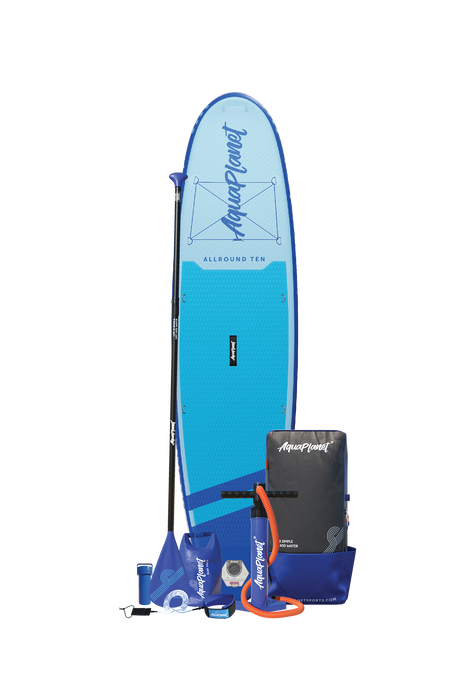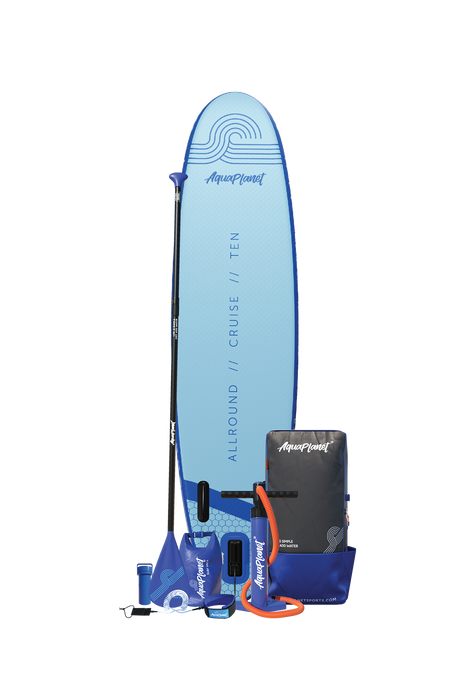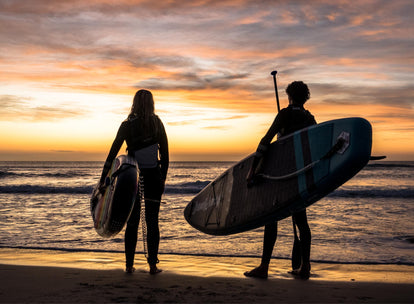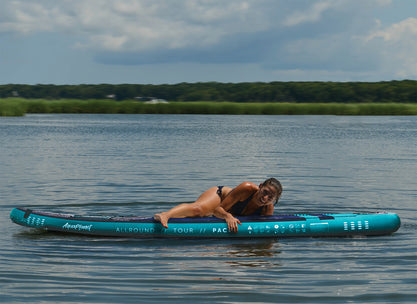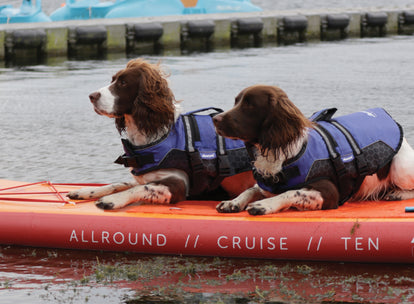Into the whitewater - A paddle boarder's introduction to WW SUP
At this time of year when the weather is colder and the rivers are higher and faster, any keen SUP’er is wistfully dreaming of summer; missing those blissful sun-kissed paddles. You may find that you notice a few hardy souls, clad in all sorts of extra gear, zooming down the local river. It has transformed into a speeding, white-capped, rough and tumble flow, causing paddlers to shout with excitement
And you think – could winter whitewater paddling be for me?
The answer of course is yes! If you’re a keen boarder who has built up a basic sense of balance and a good grasp of paddle strokes, then upping the ante in more dynamic conditions can be a great way of building your paddling skills, gaining new confidence and seeing a whole new world of water-borne fun and opportunity.

Paddleboard river running, Whitewater racing in formats like SUP-X, and river surfing (riding standing waves on your SUP, carving and performing other tricks) are growing fast in popularity so you’ll find lots of opportunities around the UK to explore wilder waters.
Of course – before you race out onto the water, you must seriously consider a few issues of safety and responsibility:
KNOWLEDGE
You should definitely understand as much as possible about fast moving water in general and of course, specifics about where you intend to paddle.
In the UK all rivers are ‘graded’. This is a system of categorising the conditions, flow and difficulty of passage to paddlers. Grade 1 is moving water, perhaps with a few riffles or small waves. Possibly fast and a little exciting for beginners, but easy to navigate and a good start for most stand up paddlers to get used to something other than flat water.

Grade 2 introduces features like standing waves and sheltered areas out of the main flow (called eddies) where you can ‘break out’ of the fast flowing water to have a rest or assess how to tackle the next section. A little more technical than Grade 1.

Grade 3 is where the river gets much more exciting – stopper waves, holes, drops, fierce eddy currents, rocks and other obstacles mean you must plan and paddle a specific line to clear technical sections of the river. You’ll want to have a few key skills down before you attempt G3 sections.

Above Grade 3 things get highly complex and this is reserved for highly experienced and adventurous paddlers. It’s worth getting to know what the higher grades look like so you can ‘read’ a river to assess it, but the vast majority of whitewater SUP will be on G3 or below.

The added challenge of being stood up on moving water means that even low grades of water can be super fun and exciting on a paddleboard.
A GREAT OVERVIEW OF THE RIVER GRADES IS AVAILABLE HERE.
Don’t forget that gradings change with river heights and conditions so you must never assume that a section you have paddled will be exactly the same grade or difficulty as before. Always check out the water before you paddle and get advice from local, regular paddlers.
Local knowledge is paramount – so why not start by getting out on the water with a whitewater SUP coach and build up your own knowledge and experience in a guided, supported environment. You will get lots of tips on technique, kit and of course, safety.
HERE’S TWO TO START WITH:
BOARD
A basic allround SUP will probably be good to tackle most G1 and G2 paddles. Being familiar with your board and how it handles can be a big advantage so you’ll probably try your first WW paddles on your normal board. But if you own a narrow, fast, touring SUP, you may find rough water a very wobbly experience!
If you’re more ambitious, you may want to look at a wider, more stable board with features such as shallow river fins (to clear submerged rocks easier), big grippy deckpads with extra foot guides and tail kickers and a shape designed for manoeuvrability, breaching waves and riding over chop.
Very short, wide boards can be great fun in play waves, but a well designed longer board between 10-11ft with 32-34” of width can still perform in rough water yet have enough glide to take you on a full day’s paddle downriver. (check out how our Wilderness WW touring board differs in look and features from the rest of our range here: WILDERNESS Adventure).
CLOTHING
There’s a bit more to think about when both winter and WW paddling – air and water temperatures are obviously cooler and you are likely to have the odd swim. On the most fun and challenging days, you could be in the water a lot!
A drysuit is the usual choice for white water paddling as it keeps you dry from neck to toes and you can decide how many layers to wear underneath to match the conditions.
Drysuits are a significant investment, so another alternative is a winter wetsuit with a splash proof jacket or ‘cag’ over the top. Wetsuits can be warm even when submerged and you can ventilate your top layer when you get hot from exertive paddling!

Also, think about the right footwear – you’ll be clambering over rocks and rough pathways as well as the river bed, so warm, tough soled wetsuit boots or kayak shoes are essential.
Gloves, hoods and neck warmers might also be part of your essential gear to stay warm and comfortable on a wild paddle.
SAFETY EQUIPMENT
Let’s list some of the other key items you’ll need:
Helmet – Essential. Get a well fitted watersports rated helmet for protection against rocks and trees. Make sure it’s comfortable and worn correctly.

Credit – @h.e.n_photography
Pads – Depending on your style of paddling or river conditions, you may want to pad up your knees, shins and elbows against impacts. Some paddlers prefer the freedom of movement without these, but it’s your own choice as to how much protection you want.
Buoyancy Aid – A well fitted 50N watersports BA will be sufficient for your first lower grade trips. In more technical waters a ‘rescue’ capable BA with a quick release body harness, pockets for additional safety gear and shaped for maximum paddling freedom might be essential. You’ll find that to attend a Whitewater Safety and Rescue course (a really, really good idea if you intend to WW paddle regularly), you will need one of these BAs and be shown how to utilise all its features correctly.

Credit – @tj.westaway
Leash – On any moving water you should wear a quick release style leash. On fast moving water it’s a great idea to ensure this is worn at chest height with the release prominent at the front. This allows you and any other third party rescuer to find and operate it quickly in an emergency.
Throwline – It can be useful to carry a throwline to assist rescuing a swimmer to the bank. But be advised you must know how to use it appropriately and have had practice. Ropes in the water can be a danger if used incorrectly and not every paddler will thank you for indiscriminately hurling yards of loose rope into their path without warning!
If carrying ropes you must also have a knife or cutter on hand to cut free if necessary.
Get training and discuss the setup and use of these with your fellow paddlers before you set off or prepare to descend a tricky section.

Credit – @tj.westaway
First Aid – Wise to carry on all paddling trips. You’ll need a waterproof kit, or a good waterproof bag for it – make sure the contents are appropriate for the group size and activity.
Communication – Your mobile will probably be tucked in your Buoyancy aid, inside its trusty waterproof case. It’s likely there’ll be some great photo and video opportunities and you’ll want it in the case of an emergency. However – WW paddling often leads you down into steep sided gorges and valleys where signal can be lost, so make sure you tell someone where you are headed and when you’ll be back. Recce your route and be sure you know some exits from the river if you decide to cut short or you need to get to help.
Group – Most important of all, whitewater paddling is ALWAYS a group activity – ideally three or four paddlers on a trip and with as much collective experience as possible.
If you want to try a new stretch, get local knowledge or see if you can join a local paddling group for a trip to get your first taste of a new river. As mentioned above, consider starting your WW adventures with a qualified coach to learn as much as you can before setting out on your own trips.

Credit – @jessphip
In summary, WW SUP can range from easily accessible fun flowing sections to big exciting complex river descents, so at whatever level you decide to try it, stay safe and happy paddling!

